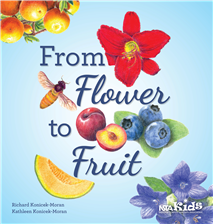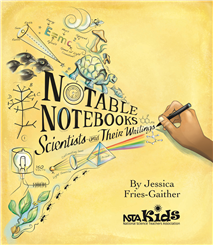Two New NSTA Kids Books Highlight Importance of Observation
By Carole Hayward
Posted on 2016-10-07
Two new children’s books published by NSTA Kids, a division of NSTA Press, are filled with rich illustrations and highlight the importance of discovery, observation, and investigation.
 In From Flower to Fruit, young scientists are encouraged to use a magnifying glass to study plants in a garden. The book, intended for grades K–4, takes readers on a colorful journey that teaches them about flowers, fruits, and bees, and how plants have special parts that help them reproduce.
In From Flower to Fruit, young scientists are encouraged to use a magnifying glass to study plants in a garden. The book, intended for grades K–4, takes readers on a colorful journey that teaches them about flowers, fruits, and bees, and how plants have special parts that help them reproduce.
The authors, Richard Konicek-Moran and Kathleen Konicek-Moran, write that flowers can provide “great teaching and learning opportunities for all ages,” and that botany is underrated as a topic for investigation because it is often considered a categorizing science. “We hope this book will introduce the discovery and wonder of botany,” the authors write.
In addition to the story, the authors include six activities for children and informative background information for parents and teachers. The book comes alive with beautiful and helpful drawings, illustrated by coauthor Kathleen Konicek-Moran. These detailed illustrations reinforce the role observation plays in science. “When you draw something, you look very closely at it and see things you might have missed if you were not drawing it,” Mrs. Maria—one of the story’s characters—says in the book.
 Sketching, writing, and recording data and observations is also a major theme of the other new NSTA Kids book—Notable Notebooks: Scientists and Their Writings. The author, Jessica Fries-Gaither, captures why journaling is such an important part of the scientific process.
Sketching, writing, and recording data and observations is also a major theme of the other new NSTA Kids book—Notable Notebooks: Scientists and Their Writings. The author, Jessica Fries-Gaither, captures why journaling is such an important part of the scientific process.
The book, written in rhyme for grades 3–5, profiles a diverse group of nine scientists (both modern day and past) and provides examples of their writings and illustrations. Dr. Jane Goodall is shown studying drawings of chimps in her notebook, Galileo’s diagram of planetary orbits is featured, and a section on Charles Henry Turner displays how his notes uncovered patterns in insect behavior. “A notebook is a place to plan experiments or tests and also to see patterns in what data could suggest,” the author writes.
Notable Notebooks includes four steps to help students create their own science notebooks. The steps encourage students to write down their findings and wonderings and share their work with family, friends, or teachers at school. “What makes a notebook special? It’s a place to think and dream, to write down thoughts and questions about all that you have seen,” Fries-Gaither writes.
Fall for These Savings on NSTA Press Books!
Between now and November 1, 2016, save $15 off your order of $75 or more of NSTA Press books or e-books by entering promo code BKS16 at checkout in the online Science Store. Offer valid only on orders placed of NSTA Press books or e-books on the web and may not be combined with any other offer.
Follow NSTA
Save
Disclaimer: The views expressed in this blog post are those of the author(s) and do not necessarily reflect the official position of the National Science Teaching Association (NSTA).

